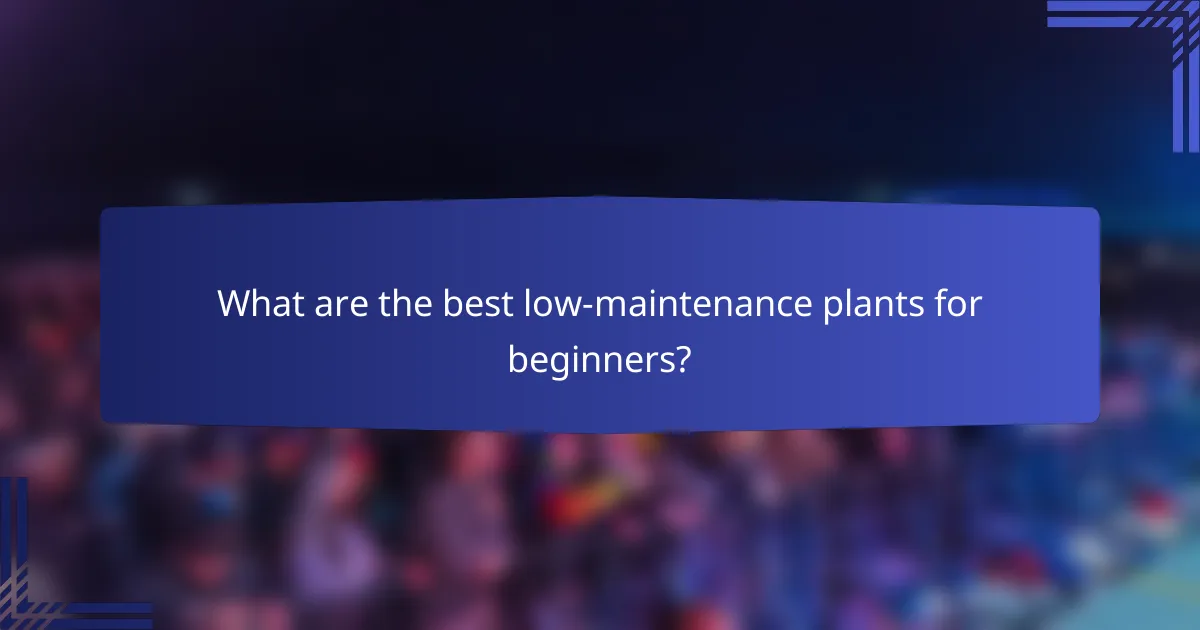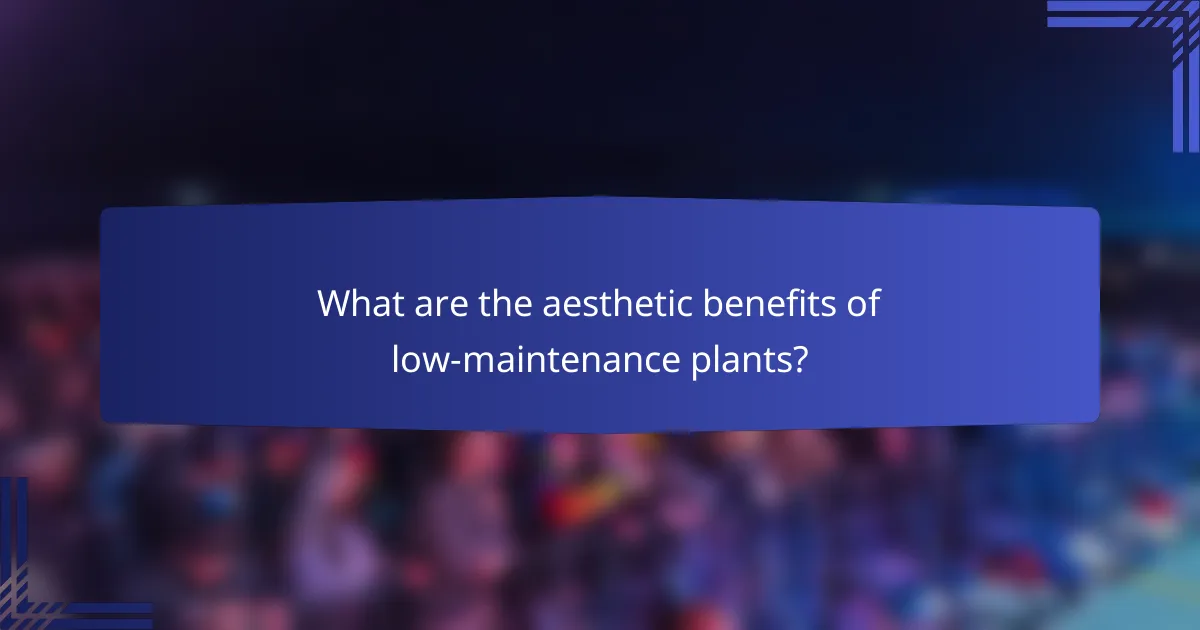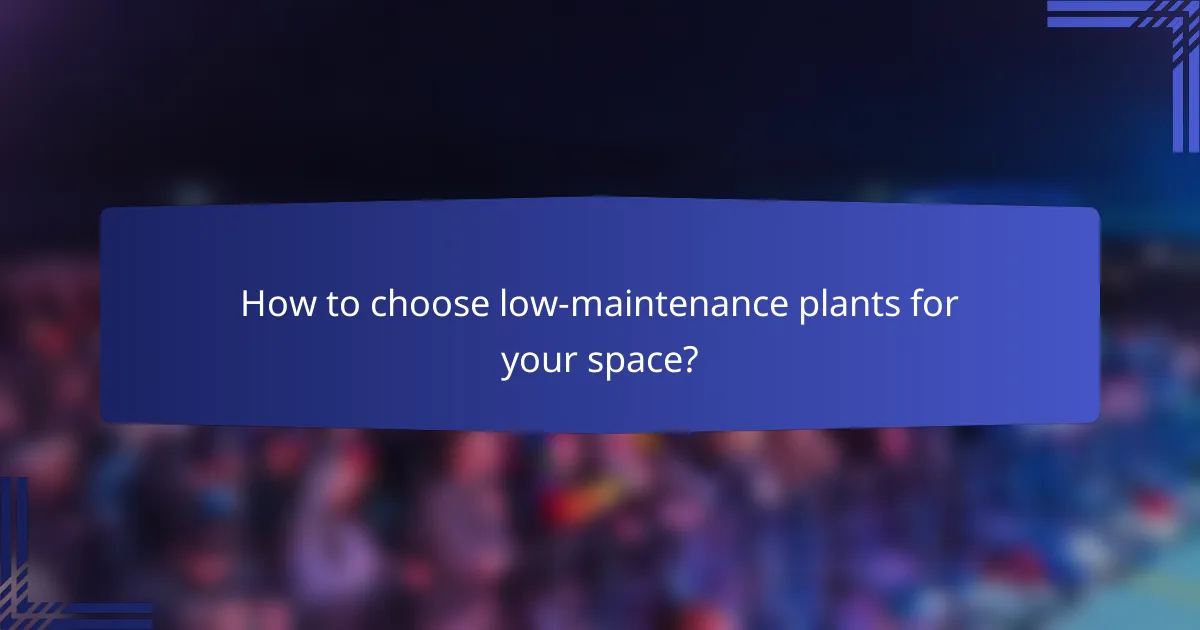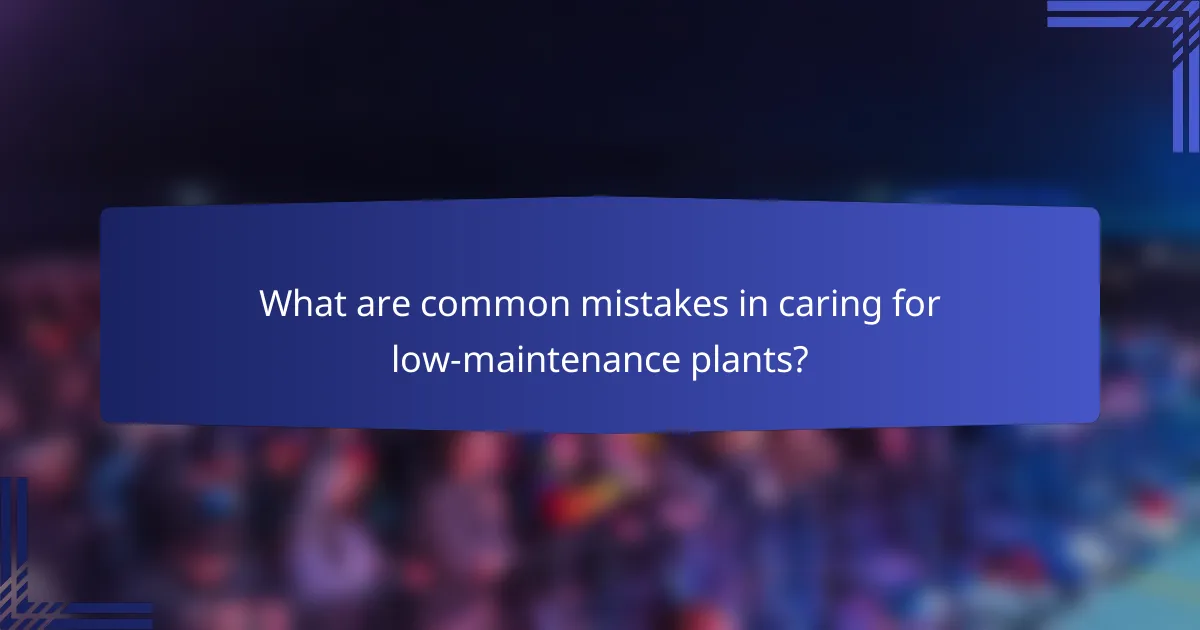Low-maintenance plants are perfect for those seeking to add greenery to their spaces without the burden of extensive care. These resilient varieties thrive in various indoor conditions, requiring minimal watering and light, making them ideal for beginners. By understanding their basic needs, you can effortlessly enjoy the aesthetic appeal they bring to your home or office.

What are the best low-maintenance plants for beginners?
The best low-maintenance plants for beginners include varieties that thrive with minimal care and are resilient to common indoor conditions. These plants typically require infrequent watering, adaptable light conditions, and are less prone to pests, making them ideal for novice gardeners.
Snake Plant
The Snake Plant, also known as Sansevieria, is a hardy indoor plant that can tolerate low light and irregular watering. Its upright, sword-like leaves can grow up to several feet tall, adding a striking vertical element to your space.
To care for a Snake Plant, water it only when the soil is completely dry, which may be every few weeks. It thrives in a range of lighting conditions, from low light to bright indirect sunlight.
Pothos
Pothos, or Epipremnum aureum, is a popular trailing plant known for its heart-shaped leaves and ability to grow in various environments. It can flourish in low light but prefers bright, indirect sunlight for optimal growth.
This plant is forgiving when it comes to watering; allow the top inch of soil to dry out before watering again. Pothos can also be easily propagated by cuttings, making it a great choice for expanding your indoor garden.
ZZ Plant
The ZZ Plant, or Zamioculcas zamiifolia, is renowned for its glossy leaves and drought tolerance. It thrives in low light and can survive with minimal water, making it perfect for busy individuals.
Water the ZZ Plant only when the soil is dry, typically every few weeks. Its slow growth means it won’t need frequent repotting, and it can adapt to a variety of indoor conditions.
Spider Plant
The Spider Plant, or Chlorophytum comosum, is an easy-to-care-for plant that produces arching leaves and small “pups” that can be propagated. It thrives in bright, indirect light but can tolerate lower light conditions as well.
Keep the soil slightly moist but not soggy, watering when the top inch feels dry. Spider Plants are also known for their air-purifying qualities, making them a great addition to any home.
Peace Lily
The Peace Lily, or Spathiphyllum, is valued for its elegant white blooms and ability to thrive in low light. It requires more moisture than some other low-maintenance plants, making it a good choice for those who prefer to water more frequently.
Water the Peace Lily when the top inch of soil is dry, and it will let you know when it needs water by drooping slightly. This plant also helps improve indoor air quality, adding to its appeal.

How to care for low-maintenance plants?
Caring for low-maintenance plants involves understanding their basic needs, which typically include minimal watering, appropriate lighting, and suitable soil types. By following simple guidelines, you can ensure these plants thrive with little effort.
Watering schedule
Low-maintenance plants generally require less frequent watering compared to more demanding varieties. A good rule of thumb is to water them when the top inch of soil feels dry, which may range from once a week to once every two weeks, depending on the plant type and environmental conditions.
Be cautious of overwatering, as this can lead to root rot. Always check the moisture level before adding water, and consider using pots with drainage holes to prevent excess moisture buildup.
Light requirements
Most low-maintenance plants thrive in indirect sunlight, making them suitable for various indoor settings. However, some varieties can tolerate low light conditions, while others may prefer bright, direct light.
To determine the best light for your plants, observe their growth patterns. If they start to stretch towards the light or their leaves become pale, they may need more sunlight. Conversely, if the leaves scorch, they might be getting too much direct light.
Soil types
Choosing the right soil is crucial for the health of low-maintenance plants. A well-draining potting mix is typically ideal, as it allows air to reach the roots while preventing water retention. Look for mixes labeled as cactus or succulent soil for optimal drainage.
For plants that prefer moisture, consider a soil blend that retains some water but still drains well. Always check the specific needs of your plant species to ensure the soil supports its growth.
Fertilization tips
Low-maintenance plants often require minimal fertilization, usually only during the growing season. A balanced, water-soluble fertilizer diluted to half strength can be applied every month or two, depending on the plant’s needs.
Avoid over-fertilizing, as this can lead to nutrient buildup and harm the plant. Always follow the instructions on the fertilizer packaging and adjust based on the plant’s response to feeding.

What are the aesthetic benefits of low-maintenance plants?
Low-maintenance plants offer significant aesthetic benefits, enhancing both the visual appeal and atmosphere of a space. Their ability to thrive with minimal care makes them ideal for busy individuals who still want to enjoy the beauty of greenery in their homes or offices.
Indoor air quality improvement
Low-maintenance plants can improve indoor air quality by filtering pollutants and releasing oxygen. Varieties like snake plants and peace lilies are particularly effective at removing toxins such as formaldehyde and benzene, contributing to a healthier living environment.
To maximize air quality benefits, consider placing one plant per 100 square feet of space. This ensures adequate coverage and enhances the overall aesthetic while promoting better air circulation.
Home decor enhancement
Incorporating low-maintenance plants into home decor adds a touch of nature that can transform any room. Plants like pothos and ZZ plants come in various shapes and sizes, allowing for creative arrangements that complement different design styles.
Use decorative pots or planters to further enhance their visual appeal. Grouping plants of varying heights can create dynamic focal points, making your space feel more inviting and vibrant.
Stress reduction
Having low-maintenance plants in your home can significantly reduce stress levels. Studies suggest that the presence of greenery can lower anxiety and promote a sense of calm, making them perfect companions for busy lifestyles.
To maximize stress-reducing effects, place plants in areas where you spend the most time, such as your living room or home office. Regularly enjoying their beauty can provide a soothing escape from daily pressures.

How to choose low-maintenance plants for your space?
Choosing low-maintenance plants involves assessing your environment and selecting species that thrive under your specific conditions. Focus on factors like light, humidity, and available space to ensure your plants require minimal care while enhancing your space’s aesthetic.
Assessing light conditions
Light conditions are crucial when selecting low-maintenance plants. Determine whether your space receives direct sunlight, indirect light, or is mostly shaded. For example, succulents and cacti thrive in bright, direct light, while ferns and snake plants can tolerate lower light levels.
Use a light meter or simply observe your space throughout the day to gauge light intensity. This will help you choose plants that match your lighting conditions, reducing the need for adjustments or additional care.
Understanding humidity levels
Humidity levels can significantly impact plant health and maintenance needs. Most indoor environments have low humidity, which can stress certain plants. Tropical plants like peace lilies and pothos prefer higher humidity, while succulents and snake plants are more tolerant of drier conditions.
To assess humidity, consider using a hygrometer. If your home is particularly dry, you might want to group plants together or use a humidifier to create a more suitable environment for humidity-loving species.
Evaluating available space
Evaluating the available space is essential for choosing low-maintenance plants. Consider the size of your area and how much room you can dedicate to plants. Larger plants like rubber trees may need more space to grow, while smaller varieties like pothos can thrive in tighter spots.
Think about vertical space as well. Wall-mounted planters or hanging pots can maximize your area while adding visual interest. Always ensure that your chosen plants have enough room to grow without overcrowding, which can lead to increased maintenance needs.

What are common mistakes in caring for low-maintenance plants?
Common mistakes in caring for low-maintenance plants often stem from misunderstanding their needs. Overwatering, inadequate light, and neglecting pest control are frequent issues that can hinder plant health.
Overwatering
Overwatering is one of the most prevalent mistakes made with low-maintenance plants. Many assume that more water equals better health, but this can lead to root rot and other issues. It’s essential to understand the specific watering needs of each plant type.
To prevent overwatering, check the soil moisture before watering. A simple rule is to stick your finger about an inch into the soil; if it feels dry, it’s time to water. For most low-maintenance plants, allowing the top layer of soil to dry out between waterings is beneficial.
Consider using pots with drainage holes to help excess water escape. Additionally, during the winter months, many plants require less frequent watering due to lower light levels and cooler temperatures, so adjust your routine accordingly.
